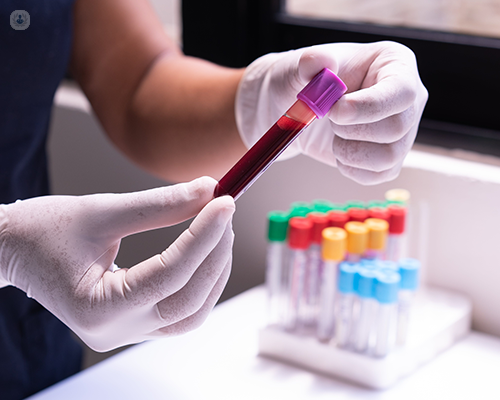Testosterone
What is analysed?
Testosterone is a hormone found in both males and females. In males, the testes produce most of the testosterone, while in females, it is produced in smaller amounts by the ovaries and adrenal glands.
Testosterone plays a crucial role in various bodily functions, including the development of male reproductive tissues and secondary sexual characteristics. The testosterone test measures testosterone levels in the blood.

What does the result mean?
The result of the testosterone test indicates the concentration of testosterone in the blood.
Why conduct the analysis?
The testosterone test is conducted to assess if testosterone levels are abnormal. The results of the test may shed light on the cause of various conditions, including erectile dysfunction, male infertility, early or delayed onset of puberty, or the presence of masculine physical features in females. Furthermore, the results can also aid in the diagnosis of polycystic ovarian syndrome (PCOS) in females.
Recently, the testosterone test has been conducted to investigate andropause, also known as the male menopause.
When to conduct the analysis?
The testosterone test is conducted:
- In young males, who are experiencing either early or delayed onset of sexual maturity.
- In adult males, who may be infertile or who have problems maintaining an erection.
- In females, who have masculine features such as excessive body hair or a low voice are present; who are infertile; who have no periods or irregular periods; or who are experiencing peri-menopause symptoms.
What sample is required?
A blood sample is required, which may need to be taken in the early morning when testosterone levels are highest. The blood is drawn from a vein the arm.
Is any prior preparation necessary?
No prior preparation is necessary.
How is it performed?
The sample is sent to a laboratory, where it is analysed using immunoassay techniques to detect and quantify the concentration of testosterone in the sample.
What are the normal values?
Normal values for testosterone levels can vary depending on factors such as age, sex, and individual health status. However, typical reference ranges for total testosterone levels in adults are:
| Total testosterone levels (ng/dL) | Interpretation |
|---|---|
| Males: 300 to 1,000 | Normal range |
| Females: 15 to 70 | Normal range |
What does having altered values mean?
- Low testosterone levels (Hypogonadism): Low testosterone levels in males can lead to symptoms such as reduced libido, erectile dysfunction, decreased muscle mass, fatigue, and mood changes. In females, low testosterone levels may cause irregular menstrual periods, decreased libido, and other symptoms of androgen deficiency.
- High testosterone levels (Hypergonadism): High testosterone levels in both males and females can lead to symptoms such as acne, excessive hair growth (hirsutism), male-pattern baldness, and mood changes. In females, high testosterone levels may also cause menstrual irregularities and infertility.